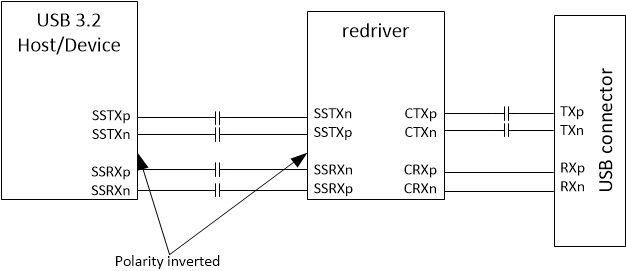ZHCSMM5A April 2022 – May 2024 TUSB1104
PRODUCTION DATA
- 1
- 1 特性
- 2 应用
- 说明
- 3 Pin Configuration and Functions
-
4 Specifications
- 4.1 Absolute Maximum Ratings
- 4.2 ESD Ratings
- 4.3 Recommended Operating Conditions
- 4.4 Thermal Information
- 4.5 Power Supply Characteristics
- 4.6 Control I/O DC Electrical Characteristics
- 4.7 USB Electrical Characteristics
- 4.8 Timing Requirements
- 4.9 Switching Characteristics
- 4.10 Typical Characteristics
- 5 Parameter Measurement Information
-
6 Detailed Description
- 6.1 Overview
- 6.2 Functional Block Diagram
- 6.3 Feature Description
- 6.4 Device Functional Modes
- 6.5 Programming
- 6.6 Register Map
- 7 Application and Implementation
- 8 Device and Documentation Support
- 9 Revision History
- 10Mechanical, Packaging, and Orderable Information
6.3.5 USB Polarity Inversion
The USB 3.2 standard requires all host, hubs, and devices support USB polarity inversion detection and correction. For this reason, polarity between TUSB1104 and USB connector as well as between USB Host/Device and TUSB1104 does not have to be maintained. Not maintaining polarity will simplify layout by eliminating the need to swap P and N in the layout. The Figure 6-1 shows example in which polarity between USB host and redriver is not maintained.
 Figure 6-1 Polarity Inversion
Example
Figure 6-1 Polarity Inversion
Example